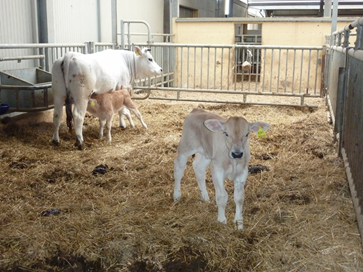As long as a heifer did not give birth to a calf, it is emitting CH4 while being unproductive. If you can decrease the age at first calving, this non-productive period will be reduced. This can be achieved by optimizing the farm management (increased quality of the feed, and monitoring of the growth and fertility). For this, it might be needed to invest in a weighing system or sensors for heat detection / fertility monitoring. The implementation process can take a few years before the effect is seen.

Benefits
The feed cost for the calf will be reduced
Challenges
Heifers have to reach a desirable weight at an age of first insemination and first calving. If the young stock management is not optimal on a farm, body weight at age of first insemination and calving will be too low with possible negative effects on later production (growth after calving), or age of first insemination will be delayed resulting in a longer non-productive interval, more emissions and higher feeding costs.
Impact
- Socio- economic resilience: Investments on fertility monitoring systems or on-farm weighing systems. Regular gestation check is required.
- Animal health and welfare: If the weight at first insemination and first calving is not optimal, there can be implications on animal welfare later in life. The impact can be on veterinary costs, longevity of the animals and herd's stock health.
- Production efficiency and meat quality: If the weight at first insemination and calving is not optimal, there can be implications on animal production later in life. Impact can be on FCR, ADG and growth. Production efficiency will increase when young stock management is improved. Optimal age of first insemination is breed specific and one has to distinguish between early and late mature breeds.
- Environmental sustainability: Less young stock or a shorter non-productive interval will lead to less emission/manure (kg CO2-eq / kg beef, carbon balance on farm, FI, FCR). Risk: the reduction in young stock being replaced by beef.
To be added: numbers of age at first calving of different breeds and the potential to reduce.